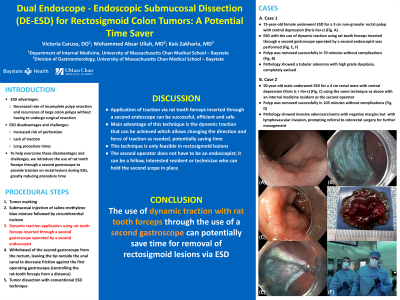Sunday Poster Session
Category: Interventional Endoscopy
P1074 - Dual Endoscope: Endoscopic Submucosal Dissection (DE-ESD) for Rectosigmoid Colon Tumors - A Potential Time Saver
Sunday, October 27, 2024
3:30 PM - 7:00 PM ET
Location: Exhibit Hall E

Has Audio
- VC
Victoria A. Caruso, DO
University of Massachusetts Chan Medical School - Baystate Medical Center
Windsor, CT
Presenting Author(s)
Award: Presidential Poster Award
Victoria A. Caruso, DO1, Mohammed A. Ullah, MD2, Kais Zakharia, MD3
1University of Massachusetts Chan Medical School - Baystate Medical Center, Windsor, CT; 2University of Massachusetts Chan Medical School - Baystate Medical Center, Springfield, MA; 3University of Massachusetts Chan Medical School - Baystate, Springfield, MA
Introduction: The advantage of endoscopic submucosal dissection (ESD) includes en bloc resection of larger tumors. However, ESD is associated with prolonged procedure time often due to technical difficulties. Unlike surgeons who can operate with two hands, endoscopists often have difficulty maintaining sufficient tension in the dissection plane during ESD. Several traction devices are available in the market. We introduce the use of traction through a second endoscope during resection of rectal lesions reducing procedure time.
Case Description/Methods: A 73-year-old female underwent ESD for a 3 cm non-granular rectal polyp with central depression (Paris IIa+c). After tumor marking, submucosal injection of saline-methylene blue mixture and circumferential incision were performed. Dynamic traction was provided using rat tooth forceps inserted through a 2nd gastroscope operated by a second endoscopist. The 2nd gastroscope was withdrawn from the rectum, but the rat tooth remained in place throughout the procedure to provide traction. The 2nd gastroscope tip was just outside the anal canal to decrease friction against the 1st operating gastroscope. Tumor dissection was performed with conventional ESD technique. The polyp was removed successfully in 70 minutes without complications. Pathology revealed a tubular adenoma with high grade dysplasia, completely excised.
A 50-year-old male underwent ESD for a 4 cm rectal mass with central depression (Paris Is + IIa+c) using the same procedure as above. The polyp was completely resected en bloc. The procedure was accomplished without complications within 103 minutes. Pathology revealed invasive adenocarcinoma with negative margins however with lymphovascular invasion, prompting referral to colorectal surgery for further management. The second scope was operated by a medicine resident under direct supervision of the main operator.
Discussion: We present ESD utilizing dual endoscope technique to successfully resect two rectal tumors. The application of traction via rat tooth forceps inserted through a second endoscope was successful, efficient and safe. The main advantage of this technique is the dynamic traction that can be achieved which allows changing the direction and force of traction as needed, potentially saving time. While involvement of two endoscopists can be cost-ineffective, the assistant endoscopist can be a fellow, interested resident (as in case 2) or technician who can hold the second scope in place. This technique is only feasible in rectosigmoid lesions.
Disclosures:
Victoria A. Caruso, DO1, Mohammed A. Ullah, MD2, Kais Zakharia, MD3. P1074 - Dual Endoscope: Endoscopic Submucosal Dissection (DE-ESD) for Rectosigmoid Colon Tumors - A Potential Time Saver, ACG 2024 Annual Scientific Meeting Abstracts. Philadelphia, PA: American College of Gastroenterology.
Victoria A. Caruso, DO1, Mohammed A. Ullah, MD2, Kais Zakharia, MD3
1University of Massachusetts Chan Medical School - Baystate Medical Center, Windsor, CT; 2University of Massachusetts Chan Medical School - Baystate Medical Center, Springfield, MA; 3University of Massachusetts Chan Medical School - Baystate, Springfield, MA
Introduction: The advantage of endoscopic submucosal dissection (ESD) includes en bloc resection of larger tumors. However, ESD is associated with prolonged procedure time often due to technical difficulties. Unlike surgeons who can operate with two hands, endoscopists often have difficulty maintaining sufficient tension in the dissection plane during ESD. Several traction devices are available in the market. We introduce the use of traction through a second endoscope during resection of rectal lesions reducing procedure time.
Case Description/Methods: A 73-year-old female underwent ESD for a 3 cm non-granular rectal polyp with central depression (Paris IIa+c). After tumor marking, submucosal injection of saline-methylene blue mixture and circumferential incision were performed. Dynamic traction was provided using rat tooth forceps inserted through a 2nd gastroscope operated by a second endoscopist. The 2nd gastroscope was withdrawn from the rectum, but the rat tooth remained in place throughout the procedure to provide traction. The 2nd gastroscope tip was just outside the anal canal to decrease friction against the 1st operating gastroscope. Tumor dissection was performed with conventional ESD technique. The polyp was removed successfully in 70 minutes without complications. Pathology revealed a tubular adenoma with high grade dysplasia, completely excised.
A 50-year-old male underwent ESD for a 4 cm rectal mass with central depression (Paris Is + IIa+c) using the same procedure as above. The polyp was completely resected en bloc. The procedure was accomplished without complications within 103 minutes. Pathology revealed invasive adenocarcinoma with negative margins however with lymphovascular invasion, prompting referral to colorectal surgery for further management. The second scope was operated by a medicine resident under direct supervision of the main operator.
Discussion: We present ESD utilizing dual endoscope technique to successfully resect two rectal tumors. The application of traction via rat tooth forceps inserted through a second endoscope was successful, efficient and safe. The main advantage of this technique is the dynamic traction that can be achieved which allows changing the direction and force of traction as needed, potentially saving time. While involvement of two endoscopists can be cost-ineffective, the assistant endoscopist can be a fellow, interested resident (as in case 2) or technician who can hold the second scope in place. This technique is only feasible in rectosigmoid lesions.
Disclosures:
Victoria Caruso indicated no relevant financial relationships.
Mohammed Ullah indicated no relevant financial relationships.
Kais Zakharia indicated no relevant financial relationships.
Victoria A. Caruso, DO1, Mohammed A. Ullah, MD2, Kais Zakharia, MD3. P1074 - Dual Endoscope: Endoscopic Submucosal Dissection (DE-ESD) for Rectosigmoid Colon Tumors - A Potential Time Saver, ACG 2024 Annual Scientific Meeting Abstracts. Philadelphia, PA: American College of Gastroenterology.


